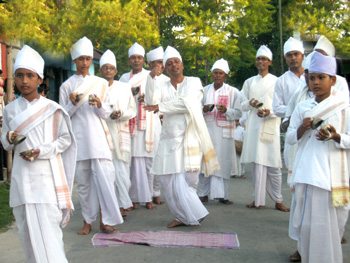Uncover the historical treasures of Assam, from the Ahom Dynasty to the vibrant Bihu festival. Explore the living chronicle that bridges the past and present.
Unraveling the Tapestry of Assam’s Past
In the northeastern part of India lies a land with a rich tapestry of history, culture, and resilience—Assam. This enchanting region, with its lush landscapes and diverse communities, has played a pivotal role in shaping the historical narrative of the Indian subcontinent. Let’s embark on a journey through time as we delve into the historical significance of Assam.
The Ancient Chronicles
Echoes of the Ahom Dynasty
The pages of Assam’s history resonate with the echoes of the Ahom Dynasty, a formidable power that ruled the region for six centuries. The Ahoms left an indelible mark, constructing architectural marvels like the Rang Ghar and Talatal Ghar. These structures stand as silent witnesses to the grandeur of a bygone era.
Battle of Saraighat: A Turning Point
The Battle of Saraighat, fought on the banks of the Brahmaputra, stands out as a pivotal moment in Assam’s history. This fierce encounter between the Ahom forces and the Mughals under Aurangzeb’s command secured Assam’s independence. The strategic brilliance displayed in this battle is etched in the annals of military history.
Assam and the Colonial Era
The Burden of Colonialism
The colonial era ushered in a new chapter for Assam. The British, recognizing its economic potential, integrated Assam into British India. The introduction of tea plantations transformed the region into a global tea hub, a legacy that continues to thrive today. However, this period also brought its share of challenges, including the Assam Earthquake of 1897, a catastrophic event that reshaped the landscape and tested the resilience of the Assamese people.
Cultural Mosaic of Assam
Bihu: The Rhythmic Heartbeat
No exploration of Assam’s historical significance is complete without delving into its vibrant cultural tapestry. The Bihu festival, celebrated with fervor and gaiety, is a testament to Assam’s agrarian roots. The rhythmic beats of the dhol and the graceful movements of the Bihu dance echo the spirit of a community deeply connected to the land.
Assamese Silk: Weaving Traditions
Assam’s silk industry, especially the Muga and Eri varieties, has a storied history. The intricate craftsmanship involved in producing Assamese silk attests to the skilled artistry passed down through generations. The silk trade not only contributed to the economic prosperity of Assam but also became a symbol of its cultural identity.
Bridging the Past and Present
Amidst the historical relics and cultural celebrations, Assam stands as a bridge between tradition and modernity. Its strategic location, bordering Bhutan, Bangladesh, and Myanmar, makes it a melting pot of influences, contributing to its unique identity.
FAQs
Q: What is the significance of the Battle of Saraighat? A: The Battle of Saraighat marked a crucial turning point, ensuring Assam’s independence from Mughal rule.
Q: How did the British colonial era impact Assam? A: The British era brought economic transformations, especially in the form of tea plantations, but also presented challenges like the devastating Assam Earthquake of 1897.
Q: What makes Bihu festival special in Assam? A: Bihu is a celebration deeply rooted in Assam’s agrarian traditions, showcasing vibrant dance, music, and cultural expressions.
Assam: A Living Chronicle
As we conclude our journey through the historical significance of Assam, it’s evident that this land goes beyond the pages of textbooks. It is a living chronicle, where every monument, festival, and tradition breathes life into a captivating narrative.

















